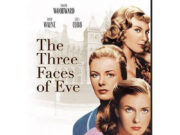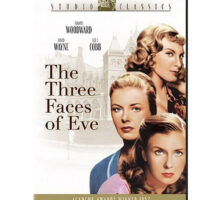The Three Faces of Eve, both a best-selling book and a major motion picture, is the true story of a young housewife who suffered from multiple personality disorder (MPD).
Her psychiatrists, Corbett H. Thigpen and Hervey M. Cleckley of the Medical College of Georgia (later Georgia Health Sciences University) in Augusta, published the book in 1957, and a film adaptation was released that same year. Produced and directed by Nunnally Johnson, a Georgia native, the film featured another Georgian, Joanne Woodward, in the title role.

By today’s standards, the book appears almost quaint and the film rather tame. This story, however, was a groundbreaker when it appeared. To understand its impact, one must consider the cultural climate of the United States following World War II (1941-45). Soldiers were returning home suffering from psychological distress, and the reality of the atomic bomb created unease among the general public.
This atmosphere fostered a keen interest in psychology and psychiatry, and general readers devoured works popularizing these previously esoteric fields. Schizophrenia and MPD—two separate illnesses—were especially fascinating and lent themselves well to melodrama. Until The Three Faces of Eve appeared, however, few clinicians had so meticulously documented and widely dispersed information on a case of MPD, and no Hollywood film had depicted the true story of an MPD patient.
The Book
Eve White (a pseudonym) was referred to Thigpen and Cleckley in Augusta by her local physician in 1951. The two doctors first wrote of her case in a seventeen-page article, which was published in the Journal of Abnormal and Social Psychology in 1954. Colleagues immediately recognized the article as the first documented observation of true MPD recorded in the twentieth century, and their response led the doctors to expand the narrative into a book, which was published in 1957.
The book recounts in detail the case of Eve White, a young housewife locked in an unhappy marriage to a well-meaning, but overwhelmed, husband. She came to Augusta seeking relief from headaches and blackouts. During one therapy session, party-girl Eve Black emerged. Eve Black knew all about Eve White and scorned White’s life and marriage as a boring waste of time. Thigpen and Cleckley treated both Eves, sometimes using hypnotism. Later, Jane, a third and more stable personality, emerged. Over many sessions, several traumatic childhood events, such as the patient’s being forced to kiss her dead grandmother, were revealed. White eventually divorced her husband, and over time her three personalities attempted resolution. The patient, who decided to be called Evelyn, later married Jim Lancaster, a man more understanding of her mental problems than her first husband had been, and the couple moved away from Georgia. The doctors were uncertain that she was fully cured but optimistic that she faced a far more stable future.
The book received praise for its meticulous documentation and its general readability. Fueled by the nearly simultaneous release of the film, it briefly achieved best-seller status.
The Film
Twentieth Century Fox purchased the film rights to the book at the urging of Nunnally Johnson, who had obtained the galley proofs in 1956. While the book was still in press, Johnson convinced the doctors to use the title The Three Faces of Eve and adapted the work as a screenplay. (Thigpen and Cleckley share writing credits for the film.) Johnson also produced and directed the film himself. His biggest challenge was to take a fairly dry, clinical case and shape it into a plot-driven narrative that incorporated characters, dialogue, and dramatic sequences with broad commercial appeal. Even as he did so, however, he used a documentary-style approach and adhered to the facts of the case more carefully than was usual for most Hollywood depictions of actual events.
To underscore its serious nature, the film is introduced by Alistair Cooke, a British journalist who also hosted the scientific documentary television series Omnibus. Cooke assures audiences that the story is true and that much of the dialogue comes directly from the clinical record, and his running narration throughout the film further adds to its documentary tone. In one major departure from the actual case, the two psychiatrists are condensed into a single character, played by Lee J. Cobb. David Wayne portrays Eve’s husband, the third major role in the film.
Johnson’s most crucial casting decision was, of course, that of the title character. He approached a number of prominent stars—including Doris Day, Olivia de Havilland, Jennifer Jones, and Lana Turner—all of whom declined the role. At various points Judy Garland, who had experienced her own emotional and psychological problems in the 1950s, was eager to take on the part, and an announcement was also made that Susan Hayward had been cast. Ultimately, however, Johnson turned to a relative newcomer to Hollywood, Joanne Woodward. She had appeared in numerous television productions but had only two major movie roles to her credit when she was cast. Johnson considered Woodward’s own Georgia background to be a major asset in playing this fellow southerner.
Most of the filming took place over two months in the spring of 1957, with a few exterior scenes shot in Savannah. The film premiered at the Miller Theater in Augusta on September 18, 1957. The reviews were mixed, but generally good. Though Eve’s rapid personality switches were documented as plausible by the psychiatric establishment, some critics, including Bosley Crowther of the New York Times, took issue with this phenomenon in the film. Critics also faulted the film for wavering unevenly between stark drama and comedy. What everyone did agree upon was Joanne Woodward’s superb performance, in which her masterful changes of facial expression, voice, and body language evoke the three personalities. She won both the Golden Globe and Academy Award for Best Actress. Although the film did only modest business at the box office, it has since come to be considered a “classic” and is shown regularly on television.
Afterword
In 1958 “Evelyn Lancaster,” with James Poling, wrote The Final Face of Eve, a perhaps prematurely titled book that attempts to fill in details of Eve’s life from the patient’s point of view. The book was moderately successful, though many critics regarded it as a dramatized rehashing of Thigpen and Cleckley’s original account. A greater milestone occurred in 1977, when Christine Costner Sizemore finally threw off all pseudonyms to reveal herself as the subject of Thigpen and Cleckley’s work in her memoir, I’m Eve. In a second book, A Mind of My Own (1989), Costner Sizemore further elaborates on her final emergence from MPD in 1974, revealing that she was treated by seven other psychiatrists and exhibited twenty-two other personalities after leaving Georgia.
Costner Sizemore became a mental health advocate, and in 1982 she returned to Augusta on a speaking tour. Neither Thigpen nor Cleckley attended her lecture, and she did not visit them, having earlier accused them of exploiting her story in both book and film. In September 2007 she returned to Augusta once again to attend the fiftieth anniversary celebration of the film, an event held at the Imperial Theater. (The Miller Theater was undergoing renovations at the time of the celebration.) In an interview published the following year, Costner Sizemore describes Thigpen’s diagnosis and treatment of her condition as “courageous” and credits him with beginning the process that ultimately restored her to health.





